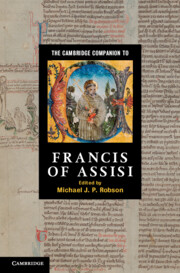Book contents
- Frontmatter
- Introduction
- PART I Francis of Assisi
- PART II The heritage of Francis of Assisi
- 10 Francis and the pursuit of learning
- 11 The early Franciscans and the towns and cities
- 12 The Third Order of Francis
- 13 Franciscan ideals and the royal family of France (1226–1328)
- 14 Franciscans as papal and royal envoys to the Tartars (1245–1255)
- 15 Franciscan missions
- 16 Pope John XXII, the Franciscan order and its Rule
- 17 The ecumenical appeal of Francis
- A guide to further reading
- Index
17 - The ecumenical appeal of Francis
from PART II - The heritage of Francis of Assisi
Published online by Cambridge University Press: 28 November 2011
- Frontmatter
- Introduction
- PART I Francis of Assisi
- PART II The heritage of Francis of Assisi
- 10 Francis and the pursuit of learning
- 11 The early Franciscans and the towns and cities
- 12 The Third Order of Francis
- 13 Franciscan ideals and the royal family of France (1226–1328)
- 14 Franciscans as papal and royal envoys to the Tartars (1245–1255)
- 15 Franciscan missions
- 16 Pope John XXII, the Franciscan order and its Rule
- 17 The ecumenical appeal of Francis
- A guide to further reading
- Index
Summary
St Francis was for centuries a saint widely revered, yet only by Roman Catholics. After the East–West split of 1054 within the Church, the Eastern Orthodox churches rarely engaged with those declared holy by Rome in the following centuries. After the fracture of the Church in the west at the time of the Reformation in the sixteenth century, Protestants included in their theological outlook a rejection of what they saw as the false claims for saints and their cults, along with the monastic system itself. A founder of a medieval religious order such as Francis therefore had little appeal for them. Even Anglicans, whose ecclesiastical position became eventually a mix of Catholic structures and reformist views, found a saint like Francis too associated with what they regarded as mawkish superstition and misdirected fervour. In any case, political events in the sixteenth and seventeenth centuries stoked fears of ‘papism’, meaning there could be little attraction in any saint closely associated with loyalty to Rome.
All the more remarkable therefore was the marked change in the nineteenth century, a period that ended with St Francis being the medieval saint most admired by Anglicans and Protestants. Adopted in various guises as one of the most inspiring religious figures in Christian history, his emergence as an ecumenical icon was astonishing.
THE ROMANTIC MOVEMENT
The origin of this change can be found in the Romantic Movement. From the final years of the eighteenth century, the social and political pressures wrought by revolutionary ideology and the chaos of the Napoleonic wars, and also by the beginnings of the Industrial Revolution, saw a reaction that involved looking back in history for inspiration.
- Type
- Chapter
- Information
- The Cambridge Companion to Francis of Assisi , pp. 273 - 287Publisher: Cambridge University PressPrint publication year: 2011

